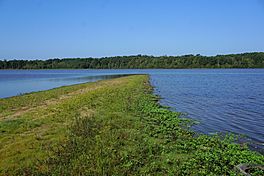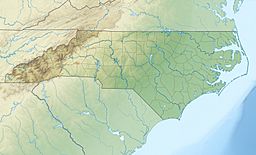Buckhorn Reservoir facts for kids
Quick facts for kids Buckhorn Reservoir |
|
|---|---|

Wetlands in the reservoir
|
|
| Location | Wilson County, North Carolina |
| Coordinates | 35°41′29″N 078°07′12″W / 35.69139°N 78.12000°W |
| Type | reservoir |
| Primary inflows | Turkey Creek and Moccasin Creek |
| Primary outflows | Contentnea Creek |
| Basin countries | United States |
| Surface area | 2,300 acres (9.3 km2) |
| Surface elevation | 146 ft (45 m) |
Buckhorn Reservoir is a large, man-made lake in Wilson County, North Carolina. It was created by building a special wall called the Buckhorn Dam. This reservoir is super important because it provides most of the drinking water for the city of Wilson, North Carolina.
The first Buckhorn Dam was built in 1974. It was about 1,000 feet (300 m) long. This first reservoir could hold about 800 million US gallons (3,000,000 m3) of water. In 1999, a brand new, bigger dam was built. This new dam created a much larger reservoir. Today, Buckhorn Reservoir covers about 2,300 acres (9.3 km2). When it's completely full, it can hold an amazing 7 billion US gallons (26,000,000 m3) of water!
Building the Buckhorn Dam
The Buckhorn Dam is about half a mile long. It was designed to be able to grow even bigger in the future. The very top of the dam is 159 feet (48 m) above sea level. However, the lake is usually only filled to an elevation of 148 feet (45 m).
This means the dam can actually hold another 6 feet (1.8 m) of water. To do this, some parts of the dam, like the spillway, would need changes. A spillway is like a giant drain that lets extra water out safely. In 2007, there was a big drought. The reservoir's water level dropped to only 60% of its full capacity. This showed how important it is to have enough water stored.
How the Water Works
Buckhorn Reservoir gets its water from two streams. These streams are called Turkey Creek and Moccasin Creek. They flow into the reservoir, keeping it filled.
Interestingly, the city of Wilson doesn't take water directly from Buckhorn Reservoir for drinking. Instead, water flows out of the Buckhorn Dam. This water travels down a stream called Contentnea Creek. It then reaches another place called Wiggins Mill reservoir. At the Wiggins Mill Water Treatment Plant, the water is cleaned and made safe to drink. This process ensures that the people of Wilson have clean, fresh water every day.



